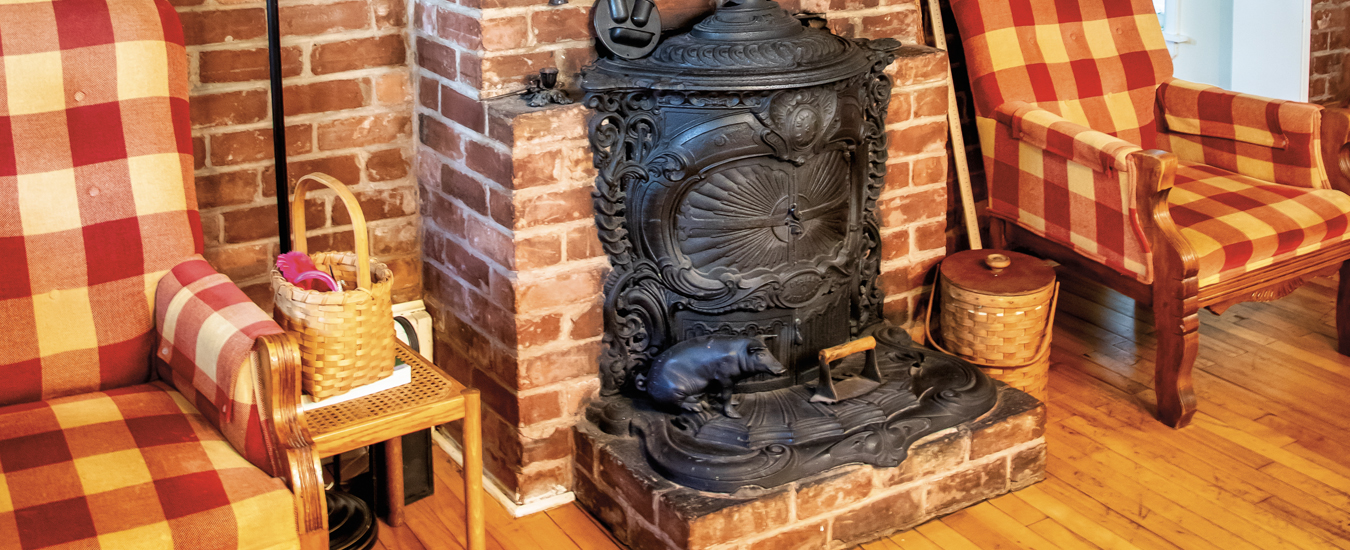At first glance, the cedar shingle siding, clad in an ocean blue, presents a humble, Maritime-style home.
But concealed within is a treasure trove of vintage discoveries, antique furnishings, and irreplaceable heirlooms, subtly commemorating Summerside’s “golden era,” a time marked by thriving shipbuilding and coastal trade, a history that lives on in this home.
Walk through the extension into the original three-bedroom house on Notre Dame Street, built during the peak of the province’s economic expansion in 1867, and enter a living museum. Here, George Dalton and wife Estelle have conserved the Victorian era of Prince Edward Island, from the wooden floorboards and exposed brick walls salvaged from the former family-owned Clifton House Hotel (bought in 1949) to the heirloom ceiling lights and everything in between, including the ornate furniture, Flow Blue china from England, and décor.
George is a direct descendant of Samuel Holland, a famous 18th-century surveyor who created the first accurate map of the Island in 1765. He says every room in their home, which he bought from his mother Helen Perkins Holland (Dalton) in 1997 for a market value of $70,000, tells a story.
“My parents were married in 1932, and my father made money from the P.E.I. fox fur trade. We lived in the Lefurgey House (a Gothic Revival-style home built in 1867, now a cultural centre in downtown Summerside) from the 1920s to the ’60s,” explains George, who is wearing a Samual Holland hat, a replica of his military uniform, which was made in Quebec.
The Lefurgey House is significant, as many pieces in the Dalton home, including a soapstone fireplace and a milk glass light in the living room, come from it. The Lefurgey House was initially built for William Tuplin in 1867, one of the foremost carriage builders of his day. In 1871, John E. Lefurgey, a leading shipbuilder, produce dealer, and politician, bought the large residence. He helped steer the Island towards constructing a railway and, in 1873, joining Canadian Confederation.
George explains why his family left the Lefurgey House and sold it to Wyatt in 1996. “I was the youngest of nine children, and we had all moved away. (George had joined the Royal Canadian Air Force in the medical branch). After my father, James Edward Dalton, died, my mother faced financial difficulties. So, she moved into this home that my father put in her name. It was one of five rental homes they had in the community.”
Helen brought many pieces from the Lefurgey House into the current Dalton home, including items from the former Clifton House Hotel (operated previously by a Mr. Titus from 1925 to 1949) that she managed, and their summer home, the Samuel Holland Homestead in North Tryon.
Bricks from the Clifton House Hotel, which burned in 1961, form a themed kitchen wall and frame a cast-iron wood stove from the Homestead in Tryon. Pinned on either side are working oil lamps from the Lefurgey House. Mounted on the bricks is a cast-iron mural featuring couples dancing, exhibiting rich history and craftsmanship. The kitchen’s wooden beams and oversized cabinets, salvaged from the hotel before it burned, add warmth.
George says his mother designed the space with the help of a carpenter and mason. Estelle mixed the old with the new, making the home a collection of meaningful things, not a catalogue of coordinated furniture.
The main living room contains a Victorian milk glass light, an original soapstone fireplace from the Lefurgey House, large ornate wooden cabinets, and blown-glass vases plucked from thrift stores and auctions worldwide.
“When Estelle and I renovated this home, there was carpet all over this floor. So, we hauled it out, revived the wooden boards, and then added this pillar from the Lefurgey House,” continues George, known locally as “Mr. History,” and recently recognized with the Mayor’s Medal of Honour for his support of veterans and local history.

George, 80, shuffles towards the staircase’s narrow steps, pointing at various pieces of art given to him by community members and veterans, and items that his mother had many years ago.
An original Thomas Jeffreys map of P.E.I. is mounted on the staircase wall. Jeffreys was an engraver and publisher of maps. He aided Samual Holland in completing his detailed map of the island in 1775. The map divided the island into three counties, Prince, Queens, and Kings, and 14 parishes.
“It’s a rare map I purchased in 1982 for $800 while stationed in Kingston, Ontario. Today, this map is worth around $4,000,” says George.
Continue to the home’s second floor, and Estelle has decorated the corridor and main bathroom with moody Gothic, Victorian-style floral and damask wallpapers. The theme continues with delicate pink floral Victorian lights in the bathroom and a large mural in one bedroom, painted by island artist Eddy Schwartz, of the family’s original 19th-century homestead. That homestead burned in 1990; new owners restored it and renewed its period charm.
The Daltons participated in the Christmas House Tours in the early 2000s while raising money for the Eptek Art and Culture Centre, and the Prince County Hospital. More than a hundred people would tour the home while learning about the items and their history.
George is glad to have the opportunity to share the treasures.
“Everything in this home is about community and friendship.”
